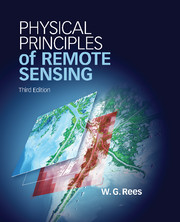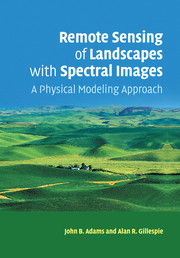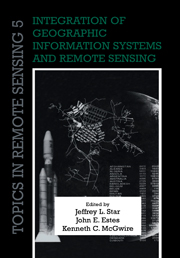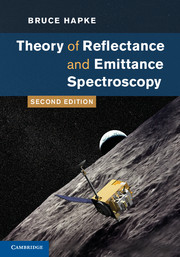Physical Principles of Remote Sensing
3rd Edition
$179.00 (X)
- Author: W. G. Rees, University of Cambridge
- Date Published: January 2013
- availability: Available
- format: Hardback
- isbn: 9781107004733
$
179.00
(X)
Hardback
Other available formats:
Paperback, eBook
Looking for an examination copy?
If you are interested in the title for your course we can consider offering an examination copy. To register your interest please contact [email protected] providing details of the course you are teaching.
-
Fully updated and containing significant new material on photography, laser profiling and image processing, the third edition of this popular textbook covers a broad range of remote sensing applications and techniques across the Earth, environmental and planetary sciences. It focuses on physical principles, giving students a deeper understanding of remote sensing systems and their possibilities, while remaining accessible to those with less mathematical training by providing a step-by-step approach to quantitative topics. Boxed examples, additional photos and numerous colour images engage students and show them how the theory relates to the many real-world applications. Chapter summaries, review questions and additional problems allow students to check their understanding of key concepts and practise handling real data for themselves. Supplementary online material includes links to freely available software, animations, computer programs, colour images and other web-based resources of interest.
Read more- Provides a thorough grounding in the physical and technical principles of remote sensing as well as providing a broad range of Earth and environmental applications
- Fully updated with significant new treatments of photography, laser profiling and image processing
- Covers a broad range of remote sensing applications and techniques across the Earth, environmental and planetary sciences
Reviews & endorsements
“This is a welcome new edition of a popular text, with wonderful color illustrations. The author has managed to help students digest the principles by adding useful summaries and review questions. A practical improvement for students and instructors is the addition of the rich suite of online resources, which greatly add to the book's appeal.”
Dr. Farouk El-Baz, Director, Center for Remote Sensing, Boston UniversitySee more reviews“Rees’ new edition of his popular remote sensing textbook is written in an easy-to-follow style, but doesn't neglect the mathematical underpinnings. It covers principles related to all the key wavelength regions, and such diverse topics as photogrammetry, atmospheric sounding and multispectral imaging. Including coverage of applications on land, in the atmosphere and oceans, it represents an excellent resource for students and practitioners alike.”
Professor Martin Wooster, Environmental Monitoring & Modelling Research Group, Kings College London“The third edition of this well known, highly respected and authoritative textbook contains a wealth of new material that captures advances in optical and microwave sensor systems and applications. University teachers will be delighted that the format remains the same; theory and technical detail are explained in clear language and supported by excellent diagrams and figures. The book incorporates good pedagogic principles that incorporate summaries for each topic, additional text boxes to help guide students not familiar with certain theoretical concepts, and review questions with problems to assist teachers to set extension exercises. The book uses excellent examples, many of which are new in this edition, that clearly demonstrate why remote sensing data from a very wide range of sensors and platforms has such an impact on science and society today. Every student of remote sensing, whatever their level, and every library should have a copy of this excellent book.”
Professor Daniel Donoghue, Department of Geography, Durham University"This is a comprehensive updating of a popular undergraduate and postgraduate text. The wealth of resources, new links and plates support the existing material superbly. The end references have been updated with new papers and sources and all the references are well integrated into the main text. … this is a superb text book and an excellent reference text. Dr W. G. Rees has done a superb job of updating what was already a well-loved and established text in a way which makes it a worthwhile investment for anyone studying the remote sensing and mapping of our planet."
Mark Nicol, Contemporary PhysicsCustomer reviews
17th Oct 2024 by UName-840234
Thorough and useful reference to principles of remote sensing of Earth I found the image processing chapter especially good in its concise definition and examples of types of processing and the basics of how they work. Throughout the book the language is very academic, formal and stilted so not as easy to read as it might be. Color plates are relegated to a center section, even though lots of the in-chapter image captions refer to color that is not visible. Earth focus means that some topics of interest to planetary scientists are not covered for that it's good to pair with Michael Shepard's Introduction to Planetary Photometry.
Review was not posted due to profanity
×Product details
- Edition: 3rd Edition
- Date Published: January 2013
- format: Hardback
- isbn: 9781107004733
- length: 492 pages
- dimensions: 254 x 203 x 27 mm
- weight: 1.22kg
- contains: 323 b/w illus. 40 colour illus.
- availability: Available
Table of Contents
Preface
Acknowledgements
1. Introduction
2. Electromagnetic waves in free space
3. Interaction of electromagnetic radiation with matter
4. Interaction of electromagnetic radiation with the Earth's atmosphere
5. Photographic systems
6. Electro-optical systems
7. Passive microwave systems
8. Ranging systems
9. Scattering systems
10. Platforms for remote sensing
11. Data processing
Appendix: data tables
Bibliography
Index.-
General Resources
Find resources associated with this title
Type Name Unlocked * Format Size Showing of
This title is supported by one or more locked resources. Access to locked resources is granted exclusively by Cambridge University Press to instructors whose faculty status has been verified. To gain access to locked resources, instructors should sign in to or register for a Cambridge user account.
Please use locked resources responsibly and exercise your professional discretion when choosing how you share these materials with your students. Other instructors may wish to use locked resources for assessment purposes and their usefulness is undermined when the source files (for example, solution manuals or test banks) are shared online or via social networks.
Supplementary resources are subject to copyright. Instructors are permitted to view, print or download these resources for use in their teaching, but may not change them or use them for commercial gain.
If you are having problems accessing these resources please contact [email protected].
Instructors have used or reviewed this title for the following courses
- Atmospheric Measurements
- Environmental Informatics and Remote Sensing
- Introduction to GIS
- Introduction to Remote Sensing
- Principles of Remote Sensing/Advanced Remote Sensing
- Remote Sensing and GIS
- Remote Sensing for Geologists
Sorry, this resource is locked
Please register or sign in to request access. If you are having problems accessing these resources please email [email protected]
Register Sign in» Proceed
You are now leaving the Cambridge University Press website. Your eBook purchase and download will be completed by our partner www.ebooks.com. Please see the permission section of the www.ebooks.com catalogue page for details of the print & copy limits on our eBooks.
Continue ×Are you sure you want to delete your account?
This cannot be undone.
Thank you for your feedback which will help us improve our service.
If you requested a response, we will make sure to get back to you shortly.
×









